Modular architecture refers to a design strategy that divides a building system into smaller pieces called modules. The modules can be fabricated independently and then used in different space compositions. They are reusable components that can be replaced without affecting the rest of the system. Growing to fit any situation and transforming to become endlessly customizable according to users’ needs are attractive attributes of a modular design. After this short definition, it’s important to set up modular architecture’s large range. Indeed, we can talk about designing with existing components like cargo containers, or building with prefabricated construction materials.
In the first place, building with cargo containers is a green and sustainable approach. The reason is that there is a lot of empty containers in harbor areas because it’s too expensive to ship them back to their original docks. In addition to this recyclable fact, to use containers reduces buildings’ ground footprint. It’s a temporary construction that can be reusable in another location.
So, shipping container architecture gets a lot of good coverage in the design world and structure’s logistics reached countries with expensive real estate including South Africa. Without a doubt, a major advantage of container architecture is the cost reduction of material and labor. After a quick count, the work cost is reduced by a hundred percent between a container construction and a high-end condo. ($55 / sq. ft. for a containers construction in South Africa as opposed to $600 / sq. ft. for a New York concrete condo, or $140 / sq. ft. for a wooden house).
But, these standard components come with a price – the lack of freedom in spatial composition. They all have the same dimensions, a rectangular base of twelve by four meters with less than eight foot ceiling. So, it’s really difficult to accommodate a comfortable bedroom in this tight wideness. Furthermore, to stay consistent with the economic primary approach, the customization is reduced to the bare minimum. That fact could be acceptable if we transform a container into offices, but it’s less convenient if we talk about residential constructions.
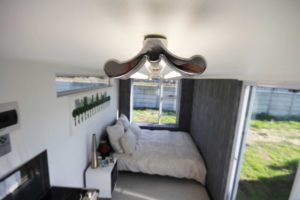
Credit: businesstech.co.za
That’s why, some architects assembled several containers together juxtaposed on top of each other to obtain a complete building. The structure is still limited but there are more possibilities. For example, in London where the real estate prices skyrocket, architects, engineers and even a decorator worked to build a Container City.
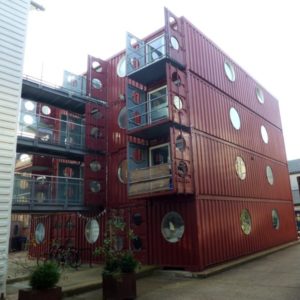
Credit: containerhomereview.com
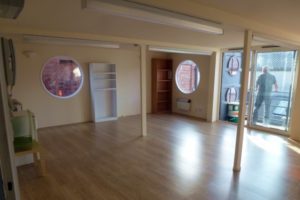
This perspective seems to open a lot of creative options. We can have balconies, bridges and even a pool with the container caliber. But, is it really ecological for the environment? When you combine more than one container, you need to affix them to the land permanently. That’s how we lose one of the most important pro-container arguments.
In addition, floors need to be replaced, and openings require to be cut with a professional torch. This operation produces a thousand of hazardous waste and uses hard machineries and an excess of fuel energy. We can also add the fuel price used for containers’ transportation if we don’t built right on site. Often, it’s cheaper and requires less energy to build wooden structures than to recycle containers.
That fact introduces my next point, which is that maybe containers are not the cheaper resource to build economic residential buildings. Maybe the right idea is the standardization process that reduces material and settlement costs. So, we can look closer to prefabricated homes and buildings.
To my knowledge, the first architects interested in prefabricated houses are Charles and Ray Eames. In the mid-1940s, they designed a series of case study homes for the modern world by ordering pre-fabricated materials from catalogs. They wanted to maximize volume and minimize materials and their environmental print. When we think about that, we are very close to container house’s philosophy. It’s an attitude to repair and justify our mass-production society.
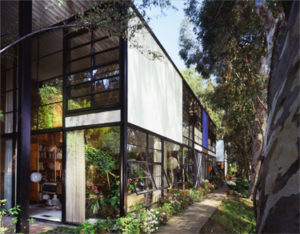
Credit: studiourbanblu
With a demographic increase and residencies’ mass production, a lot of modern architects had a keen interest in standardizing and streamlining the building design process. I would just quote one example which, in my opinion, is the most significant and relevant project. It’s Habitat 67 built by Moshe Safdie in Montreal. He built his career by specializing in high density complexes. He wanted to lower the construction cost by assembling prefabricated three-dimensional modules. The result looks like a mountain carved by the condos juxtaposition. Beyond the economical aspect, his project is an example of research about the quality of life and uniqueness for every user. Indeed, every apartment has four orientations. A private terrace open to the sky and windows are designed to avoid neighbor views with all the assets that can be found in a private house. This project was acclaimed worldwide and recognized for its inventive experience of urban living, but it failed to revolutionize affordable housing because of over budget costs. But, it’s a step forward in terms of scalability – from just homes to large scale apartment developments.
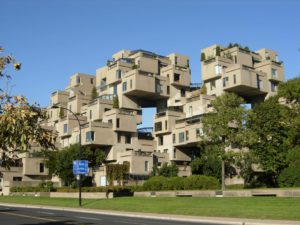
Credit: nationalacademy
I would like to introduce my vision of affordable housing in closure, through a pick at my speculative research project called Unicity. The mixed use complex deals with issues relating to live in crowded city, such as density, life quality and individual singularity inside society.
The project develops divers condos built from a 20/20 ft. module. The houses stacking allows to open private terraces. Every apartment typology matches with different stages of a person’s life (student, grown up or family) and expands on various high to be conform to established urban context.
A high interest has been granted to construction details, we use only standard components features, but they appear like high-end finishes. Every elevation is processed in a unique way, and users can recognize their own house in the aggregation.
To save money, all of the shared spaces like bridges and terraces are prefabricated wood components. Wood is cheap to manufacture, allows high range and doesn’t need to be cover like with concrete components.
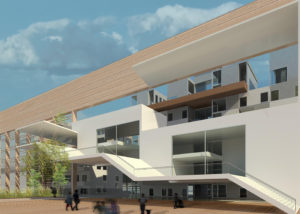
Container architecture are one manifestation of modular architecture. It stands out through low construction costs. But, in my opinion building with a recycled material is not always the more sustainable or economical approach. In order to preserve its minimal footprint on the environment, container structure should stay an emergency option for example to build quickly refugees camps.
Furthermore, can we consider recycled and temporary container house as an architectural gesture? According to Paul Valery, architecture’s origins are “the grave or the treasure”. The grave is the first human settlement. This is a construction that can express a will to cross time. In the same way, the treasure is a warehouse that can keep future provision and allow men’s survival. The original definition of architecture is to build perennial constructions. So, creating temporary architecture wouldn’t be conflicting with architectural roots?
